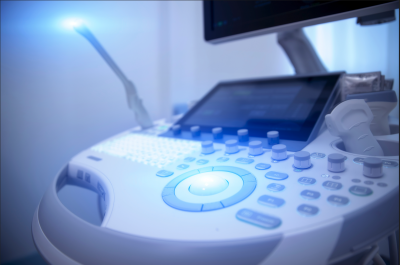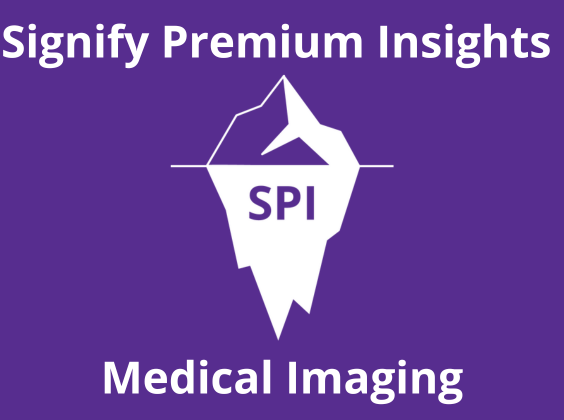
Written by

For the first time at ECR there was a dedicated section of the Expo for AI, the Artificial Intelligence Future Lab, with seven exhibitors and a mini-theatre for presentations. There were also a handful of medical imaging AI companies dotted around the main exhibition halls and most of the major vendors found an angle to add AI to their booths. Although there were no major AI-related vendor announcements at ECR, it was evident from walking the exhibition floor that AI continues to make in-roads into medical imaging and the pace of technology commercialisation is accelerating. Some of the main themes are discussed below.
PACS Integration Gets Tighter
For AI to become mainstream in medical imaging, the tools need to be fully integrated into the radiologists’ existing workflow. Most generalist radiologists will prefer to access the results from AI algorithms from within their diagnostic viewer, which in most cases today is a PACS. Coming out of PACS to a dedicated AI platform adds an extra step in the process and hence additional time; particularly hard to justify for AI platforms with a narrow offering of algorithms. An exception could be targeted use-cases, e.g. breast imaging, where radiologists may already be used to working with a computer-aided detection (CADe) workstation. Radiologists who already use a dedicated advanced visualisation (AV) platform may be comfortable with accessing certain AI tools, such as quantitative imaging tools, in an AV environment, although some convergence of AV and PACS is occurring and over time we expect to see more AV tools made available in PACS. As the industry transitions to enterprise imaging and universal viewers, AI developers need to forge partnerships with the leading imaging IT vendors to best position themselves for future growth. Over the coming years, we expect to see PACS, AV and other clinical IT platforms, such as oncology, pathology, breast imaging, cardiology, dermatology and orthopaedics, absorbed into enterprise platforms, giving AI developers access to a richer set of data to work with.
Forming partnerships with PACS vendors can enable tighter integration of AI tools for an enhanced user experience. The AI results can be directly overlaid on the images and the radiologist can make edits and annotations. A tight PACS integration can also give access to the worklist, so that cases can be prioritised in the reading list based on the initial AI findings.
The Dutch company Aidence is taking this approach and has integrated its Veye Chest Detection solution with PACS from Agfa and Sectra, negating the need for a specific AI user interface. Veye Chest Detection automatically detects and marks pulmonary nodules on chest CT scans. Aidence received CE Mark Class 2a for Veye Chest Detection in December 2017. Aidence is also developing a solution for automatic quantification of nodules, such as volume, composition and axial diameters, as well as the ability to automatically track volume changes over time, and plans to release these additional functionalities in the second half of 2018.
Aidoc has taken a similar approach and fully integrates its AI solution in the PACS workflow, without a dedicated AI platform. Whereas most AI solutions are built for specific pathologies, Aidoc takes a different approach and analyses complete body areas to detect potential abnormalities. The software can then prioritise cases in the worklist. Aidoc received CE Mark for its head and cervical spine solution in November 2017 and plans to release two additional solutions for abdomen and chest applications later this year. Aidoc is targeting acute findings only and does not provide quantification. The company has a co-marketing agreement with Agfa and is seeking partnerships with other PACS vendors.
The benefit for PACS vendors in forming partnerships with medical imaging AI developers is two-fold. Firstly, it represents an additional revenue stream, albeit a relatively small one in the short-term. Secondly, they can offer their customers a wider range of AI tools and be faster to market than if they rely on in-house development, maintaining their reputation for technology innovation and to obtain a competitive edge. Being seen as a technology innovator is important for winning contract renewals and maintaining market share. It is also a light touch way to bring new AI tools to market and test customer interest, before investing in in-house development or making an acquisition.
AI Marketplaces Making Progress
As we mentioned in our RSNA show report (AI at RSNA – What a Difference a Year Makes), online AI marketplaces provide algorithm developers with workflow integration and a route to market. EnvoyAI used ECR for its European launch and now has 19 developers with 46 products on its platform. EnvoyAI has a distribution agreement with TeraRecon to sell and market the EnvoyAI platform and it plans to add more distribution partners this year. Shortly after ECR, TeraRecon, EnvoyAI and Ambra Health announced a partnership, whereby health providers can access the EnvoyAI Exchange from Ambra’s image exchange workflow. EnvoyAI plans to go live with its first hospital customers in the coming weeks.
Siemens also showed its Digital Ecosystem marketplace at ECR 2018. It was first announced at HIMSS 2017 with a handful of partners on board and Siemens has added several new partners over the last year. The current list of partners now includes solutions for image analysis (AMRA, Arterys, Circle Cardiovascular Imaging, Combinostics, HeartFlow, Mint Medical, Pie Medical Imaging, Precision Image Analysis, SyntheticMR), surgical (ExplORer Surgical, mediCAD), teleradiology (Second Opinions, TMC) and operational and business Analytics (Cranberry Peak, Stroll Health, Viewics, Dell-EMC).
During ECR, Philips announced the launch of an AI development environment, HealthSuite Insights, which includes the Insights Marketplace, an ecosystem of AI tools from Philips and third parties (from late 2018). We expect more modality and imaging IT vendors will launch AI marketplaces this year.
Imaging Biomarkers Becoming More Prolific
Three of the seven exhibitors in the Artificial Intelligence Future Lab were quantitative imaging specialists; namely, icometrix, Quantib and Quibim. There were also quantitative imaging solutions on show from CorTechs Labs, Medis and Mint Medical in other parts of the Expo, as well as quantitative post-processing software from the leading advanced visualisation and modality vendors. Of these, the Quantib and Quibim solutions use deep learning technology, whilst the others use traditional image processing techniques.
icometrix specialises in neurology and provides MRI imaging biomarkers for the diagnosis of neurodegenerative diseases, such as Alzheimer’s and multiple sclerosis, and traumatic brain injury. Quantib is also currently focused on neurology and provides software for automatic segmentation and quantification of brain tissue to diagnose the presence of atrophy related to neurogenerative disease. Quantib recently secured 4.5 million euros of funding and is now developing quantitative imaging solutions for prostate, liver and orthopaedics applications. Quibim offers one of the broadest portfolios of imaging biomarkers, covering abdomen, lung, musculoskeletal, neurology and oncology.
One of the barriers preventing the more widespread use and acceptance of imaging biomarkers is a lack of trust from clinicians in the accuracy and repeatability (precision) of quantification software. Typically, the accuracy will be higher than can be achieved manually, but there can be considerable variability, anecdotally quoted at around 20%-30%, between the results from different vendors that offer the same biomarker. To address this, Quibim has made the validation process and clinical test results for its imaging biomarkers available on its website. A bold move, but one that should help to strengthen the perception of quantitative imaging.
More Than Image Analysis
Whilst many of the medical imaging AI start-ups are focused on image analysis, imaging IT and modality vendors are applying AI to a broader range of imaging applications, including pre-, intra- and post-scan. For example, in pre-scan, AI can be used to ensure the patient is correctly positioned and the optimal scan protocol is used. During the scan, AI can detect additional abnormalities than the initial target and optimise the scan for incidental findings, potentially eliminating the need for additional scans. Post-scan, in additional to the usual post processing applications, such as detection, segmentation and quantification, AI can be applied for practice management (e.g. quality and outcome assessment tools) and radiologist workflow, such as adaptive hanging protocols, automatic retrieval of priors, etc. An additional example is the use of deep learning to improve the image quality of low-dose CT images.
Many of the modality and imaging IT vendors are initially focussing their in-house AI developments on practice management and workflow, with clinical applications seen as a longer-term play. Partnering with AI specialists is an effective way of establishing an initial offering of clinical AI solutions, so as not to be seen as a laggard. Since radiologist workflow is essentially ingrained in the PACS, it makes sense that the imaging IT vendors want to control the development of AI-powered workflow tools. Moreover, there are fewer challenges with bringing these solutions to market, such as fewer regulatory requirements.
Conclusion
At this year’s ECR it was clear that AI is rapidly extending its reach in medical imaging, be it the tighter integration in PACS, the growing number of online AI marketplaces, the increasing availability of regulatory cleared products or the increasing AI activities of the modality vendors. However, AI didn’t seem to generate the same buzz and excitement as it did at RSNA. Perhaps this is a positive sign that AI is now descending the peak of the hype cycle. Or perhaps it’s a sign that European radiologists aren’t yet fully embracing AI? In the US, several luminaries in the radiology community have championed the use of AI. Maybe Europe needs its own medical imaging AI champions.
Related Market Report
“Machine Learning in Medical Imaging – 2018 Edition” provides a data-centric and global outlook on the current and projected uptake of machine learning in medical imaging. The report blends primary data collected from in-depth interviews with healthcare professionals and technology vendors, to provide a balanced and objective view of the market.
About Signify Research
Signify Research is an independent supplier of market intelligence and consultancy to the global healthcare technology industry. Our major coverage areas are Healthcare IT, Medical Imaging and Digital Health. Our clients include technology vendors, healthcare providers and payers, management consultants and investors. Signify Research is headquartered in Cranfield, UK.
More Information
To find out more:
E: simon.harris@signifyresearch.net
T: +44 (0) 1234 436 150
www.signifyresearch.net

